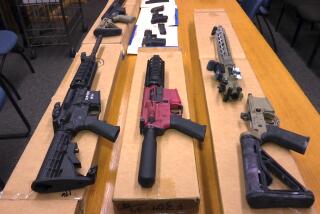WWII Rifles Spark Bitter Battle With White House
WASHINGTON — Ask any GI who was at Guadalcanal or Omaha Beach about his M-1 Garand rifle, and perhaps he’ll squint and recollect the gun that many say was the greatest weapon of World War II, hard to jam and accurate to 1,000 yards. It’s one of the few firearms with a fan club and an Internet home page.
But M-1s in good condition are scarce and, at as much as $1,000 apiece, in demand by gun dealers.
With that in mind, the U.S. gun industry hopes to make a fortune importing into this country millions of M-1s and other surplus American military firearms that the Pentagon gave away or sold at a discount to U.S. allies during the Cold War.
The Clinton administration opposes the idea, saying many of the guns can easily be converted to automatic weapons and are attractive to criminals. Clinton aides also believe the imports would provide windfall profits to U.S. gun dealers and to nations--such as the Philippines, Turkey and Pakistan--that received the guns at little or no cost.
Turning to Congress for help, firearms-industry executives have told legislators they have backing from a prominent figure: John H. Sununu, President George Bush’s first chief of staff.
In recent months industry representatives have told members of Congress, federal officials and others that Sununu supported the gun-import plan of key firearms wholesalers, including the Massachusetts-based Lew Horton Distributing Co., industry and federal officials said.
The firm has applied to the Treasury Department for permission to import 820,000 M-1 Garands, M-1 carbine rifles and .45-caliber M1911 pistols from the Philippines, the officials said.
Other gun dealers have applied to import many thousands more firearms that were donated to India, Morocco, Turkey and other countries.
Besides Sununu, the gun importers have enlisted lawyer-lobbyist Mark Barnes, who represents the Lew Horton firm, a gun-import trade association and the National Rifle Assn. Barnes used to work for Sen. Ted Stevens (R-Alaska).
Barnes helped persuade Stevens to introduce an industry-backed measure to allow millions of M-1s, M-1 carbines and M1911 pistols into this country from any nation. In July, with no debate, Stevens got a Senate committee to pass the industry provision. In September he got it inserted into the continuing resolution--an emergency spending bill that traverses Congress at lightning speed.
In late September, Republicans removed the provision in the face of stiff White House resistance. But Stevens’ spokesmen and industry representatives said they hope to get it enacted soon. All sides agree it probably will pass.
The guns at issue are militarily obsolete and no threat to anyone, a gun-industry lawyer said, but are prized by firearms enthusiasts. “These are hobbyists just like collectors of art and antiquities, interested in a period of history and an investment,” the lawyer said.
Sen. Frank Lautenberg (D-N.J.) disagrees. “These weapons . . . are designed for war,” he told colleagues in a letter. “Our own Department of Defense does not allow these weapons to be sold [commercially]. . . . Why should we allow foreign countries to do so?”
The types of guns in the dispute generally sell for $300 to $500 here, but the importers contend that they could sell them for as much as $1,000 each, depending on their condition. Some are in used condition while others are in excellent shape, still packed in grease, officials said.
Criminals are unlikely to lug the heavy, bulky M-1s to robberies and shootouts. But law enforcement authorities worry that the other two types sought for import would be used in crimes, especially the M-1 carbines, which can be quickly converted into fully automatic weapons.
The debate goes back to 1968. After several national leaders were assassinated, Congress passed the Gun Control Act, which, among other things, banned the import of all military surplus weapons from any country.
But in 1984, the gun industry turned for help to one of its allies over the years: then-Sen. Bob Dole (R-Kan.). In response to industry and NRA lobbying, Dole pushed through Congress an amendment to an obscure trade bill that overrode the 1968 act, allowing the importation of all guns on the U.S. “curios and relics” list--those older than 50 years or tied to a historical event such as a war.
But the import of the M-1s and other U.S. guns held by foreign militaries remained legally ambiguous. While the Dole law said they could come in, an arms-control law placed strict limits on what other nations could do with U.S. weapons sent overseas.
In 1987 Congress acted again at the behest of the gun industry, changing the arms export law. Again, the industry’s congressional allies attached the measure to a continuing resolution that was approved with little debate.
That 1987 congressional action opened the door for a deal that the Customs Service had been blocking for a year--the import of 200,000 M-1s worth $60 million from Korean military arsenals.
Clinton’s State Department has blocked all later attempts to import the U.S. guns, citing arms-export laws as a basis.
On Sept. 30, White House officials, in negotiations with GOP leaders over the continuing resolution, strongly opposed allowing imports of the World War II guns the industry wants. Instead, the administration said it would agree to a bill allowing importers to bring in only older, 75-year-old rifles.
Republican leaders refused the White House offer in hopes of enacting the GOP version later.










